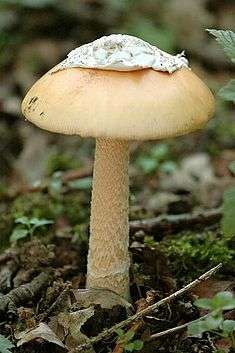Amanita subpallidorosea
Amanita subpallidorosea is a mushroom of the large genus Amanita, which occurs under oaks in southern China and Taiwan. It is closely related to the destroying angel mushrooms A. virosa and A. ocreata.[1]
| Amanita subpallidorosea | |
|---|---|
| Scientific classification | |
| Kingdom: | |
| Division: | |
| Class: | |
| Subclass: | |
| Order: | |
| Family: | |
| Genus: | |
| Species: | A. subpallidorosea |
| Binomial name | |
| Amanita subpallidorosea | |
Two people died in 2014 after eating mushrooms picked near Zunyi in Guizhou province in southwestern China; investigations led to the description of Amanita subpallidorosea in 2015.[1] Molecular analysis found it to be closely related to the destroying angel species A. virosa and A. ocreata.[2] The mushrooms all belong to a clade within the section Phalloideae, a large group of highly toxic mushrooms responsible for the deaths of many people worldwide.[1]
A. subpallidorosea is a medium-sized mushroom, that is predominantly white. The cap is initially conical, before becoming more convex and flattening , sometimes with a central boss. Measuring 3 to 6.5 centimetres (1 1⁄4 to 2 1⁄2 in) in diameter, the cap is white initially, before developing a pale pink, more prominently in the centre and paler at the margins. It can be slightly sticky when wet. The flesh is white. The crowded gills are free and around 4 mm deep. The stipe is 7 to 12 centimetres (2 3⁄4 to 4 3⁄4 in) high and 0.6 to 1.4 centimetres (1⁄4 to 1⁄2 in) thick, is white, cream or pale buff in colour and bears a thin white membranous ring. The bulb at the base is 1.5 to 3 centimetres (1⁄2 to 1 1⁄4 in) across. The spore print is white, and the round amyloid spores are 8–12 x 8–12 μm viewed under a microscope. Their surface is smooth. The mushroom turns yellow when potassium hydroxide is applied to it.[2]
It can be distinguished from Amanita pallidorosea as the latter's cap has a pronounced boss and its spores are smaller when viewed under a microscope. Other lethal amanitas in China are generally white.[2]
A. subpallidorosea is found under oaks of the genera Quercus and Cyclobalanopsis in Guizhou province as well as Taiwan.[2]
See also
- List of Amanita species
- List of deadly fungi
References
- Cai Q, Cui YY, Yang ZL (2016). "Lethal Amanita species in China". Mycologia. 108 (5): 993–1009. doi:10.3852/16-008. PMID 27474516.
- Li HJ, Xie JW, Zhang S, et al. (2015). "Amanita subpallidorosea, a new lethal fungus from China". Mycological Progress. 14 (43): 11. doi:10.1007/s11557-015-1055-x.
